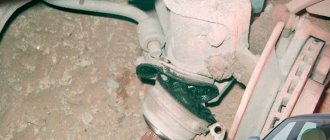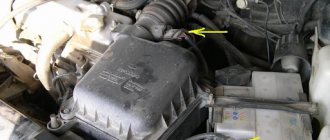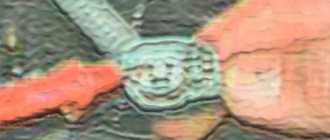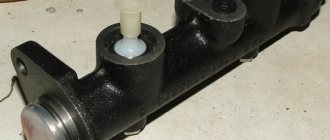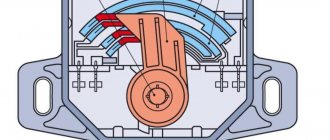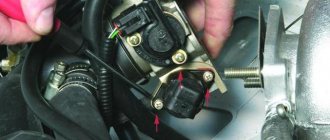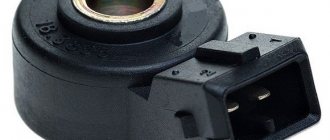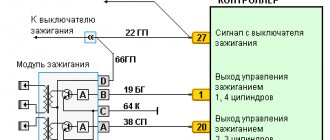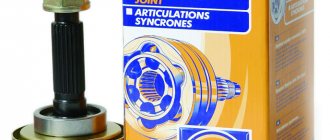Reading time: 4 minutes(s) Some car owners do not pay attention to the CV joint until serious problems appear in it, which can no longer be ignored. This often happens due to ignorance of the specifics of how to check the CV joint on a car.
If we consider the purpose of a CV joint briefly, it is a special joint designed to transmit torque from a car’s gearbox (regardless of whether a manual transmission or automatic transmission is installed on the car) to the wheels. In front-wheel drive or all-wheel drive cars, transmission occurs with minimal losses even with significant changes in the drive angle.
CV joints on a car
Failure of the CV joint can lead to wheel locking while driving, which will cause a serious accident. Accordingly, you need to know how to check the CV joints for serviceability and periodically check them.
External and internal grenade (CV joint): differences and features
So, before checking the CV joints, it is necessary to separately take into account a number of features. First, the hinges can be internal or external. So, they rarely fail at the same time. In fact, the outer CV joint breaks more often. However, it cannot be ruled out that the problem is not, for example, the left internal grenade or the right internal hinge.
At the same time, to an inexperienced car enthusiast, both internal and external CV joints may seem the same. In fact, they differ in terms of design, experience different loads, have different operating modes, and the very signs of their malfunctions are somewhat different from each other. Let's figure it out.
- The design of the outer and inner CV joints is somewhat different due to the different operating modes of these hinges. The outer CV joint is connected to the hub, and its main task is the need to transmit torque at any angle of rotation or inclination of the wheel.
- In turn, it is important for the inner joint to compensate for the misalignment of the transmission and the drive shaft, thereby partially relieving the outer CV joint. At the same time, the internal joint ensures complete “integrity” of the shaft, provided there is a large suspension travel. In other words, it is the inner CV joint that allows the drive shaft to become slightly longer or shorter under certain conditions.
- If you compare the hinges visually, the body of the inner CV joint is larger than the outer one. Due to this, the inner race of the CV joint can move along with the shaft and balls inside the housing along the tracks. Also, the inner hinge can be rotated at an angle, although less than the outer hinge. If we consider the outer CV joint, it is rigidly fixed to the shaft and is more responsible for the ability to turn. On some cars, the outer grenade is so firmly attached to the shaft that it must be cut off to remove it.
Let’s also add that a special lubricant for the CV joint is placed in the joint cavity. This lubricant protects the element from moisture and shock loads. Please note that the CV joint cannot be filled with lubricant of unsuitable properties and type. In this case, the constant velocity joint will quickly fail.
Also note that front-wheel drive cars have a transverse engine, that is, the gearbox is shifted to the left. The result is that the left drive shaft will be shorter than the right one. So, the longer right shaft is not always solid. There are options when it is made of two parts, which are connected using a suspension support (suspended bearing).
The fact that on some cars a tripod is used as an internal joint, rather than the usual type of CV joint discussed in the article, deserves special attention. In any case, the operating principle of the tripod is still similar and there are no fundamental differences.
Hinge design
The transition from rear-wheel drive to front-wheel drive required automakers to develop new technical solutions. The transmission of rotation to the steered wheels is associated with large rotation angles. The driveshaft installed on rear-wheel drive cars could not cope with this task due to the limited turning angle and low efficiency. But, after changes were made to the design, it became the prototype of the modern constant velocity joint.
Automotive parts manufacturers produce two types of CV joints. The first is called "rtseppa" (better known as "six-ball"). It consists of two cages (inner and outer), steel balls and a separator separating them. Thanks to precision manufacturing and minimal clearances, the coupling can transmit high torque at high speeds and rotation angles of up to 60°.
The second type of CV joint is a “tripod”. Its design was developed in Japan, where it is used on some cars. Its structure is somewhat more complicated than that of a rzeppa, but it is capable of transmitting rotation at an angle and moving along its axis. The tripod consists of a body in which a three-rayed star with spherical rollers and a fork with profile grooves are fixedly fixed. The disadvantages of this design are the inability to work at angles exceeding 30°, the complexity of manufacturing and, as a consequence, the high price.
Regardless of the design and manufacturing technology, the drive components must be equipped with a boot secured with clamps and a locking ring to secure the part to the shaft. Damage to one of them is a reason to check the CV joint (grenade) on the car. The entry of water, sand or dirt into the internal cavity is unacceptable. Foreign substances will cause intense wear on the working surfaces and damage the drive.
The appearance of traces of grease on the outer surfaces of the boot is one of the signs of a faulty CV joint.
The hinge, whether it be a hinge or a tripod, cannot itself transmit rotation to the wheel hub. It is an integral component of a drive consisting of a shaft and two CV joints (internal and external). The first is made of thick-walled pipe with a diameter of 25-35 mm. The internal one is installed on the gearbox, and the external one on the wheel hub. The first one works at rotation angles not exceeding 30°, which allows you to install a tripod there. A CV joint of the CV type is fixed on the outer side.
However, during operation, the drive perceives not only torque loads. While the car is moving, the suspension swings, which leads to a change in the distance between the hinges. To compensate for this, the drive shaft in the inner CV joint can move along splines. In premium cars, a tripod with a rigidly fixed axle shaft is installed in this place. This design is more reliable, but more expensive than a drive assembled on the basis of simple CV joints.
Internal CV joint device
The internal constant velocity joint is designed to transmit torque from the transmission to the outer CV joint. It differs from the external one in size (increasingly) and cost, although it consists of the same parts:
- Bowl-shaped housings with a driven shaft.
- The inner race is a spherical fist with a drive shaft.
- A separator in the form of a ring with holes to hold the balls.
- Metal balls.
The roller type of hinge is characterized by the presence of a support, which, using three rollers, moves along tracks cut into the inside of the body. The balls or rollers are located in the grooves of the housing and are held by a cage, which is connected to the drive shaft by a splined joint. When the angle of the drive and driven shafts changes, the balls move along the grooves, continuously transmitting force.
Service life and maintenance
A grenade in a car is a consumable item. It will have to be changed quite often. Fortunately, the cost of the unit and repairs is usually not the highest.
How much a factory part costs depends on three factors:
- Driving manners;
- Machine models;
- Timely service.
The first factor is critical. Grenades are especially afraid of the trigger falling down when the steering wheel is turned to the extreme position. At such moments the node experiences maximum load.
If you mostly move calmly, then you can look for a resource for your car on thematic forums. There are cars in which a standard product can cost more than one hundred thousand.
Timely maintenance means periodic inspection of the boots, their timely replacement and filling with lubricant. If a crack appears in the rubber, the death of the CV joint will occur in just a couple of weeks. And in rainy weather this can happen even faster. This is due to water, which, when it gets into the assembly, leads to corrosion and leaching of the protective lubricant.
Surely you will be interested to know that in addition to grenades, absolutely all ordinary cars have a TV! Be sure to read our article on this so you can be a knowledgeable car owner.
A torn boot is a typical malfunction.
Boots, by the way, are quite inexpensive. The lubricant is also cheap and is called tritely - “CV joint”. When purchasing, do not forget to check that the anthers come with clamps for tightening them.
Advice on how to extend the life of a grenade:
- Do not press the pedal to the floor when turning, especially when starting off
- Change boots and lubricant in a timely manner
The lifespan of external and internal grenades is very different. The first is subject to great effort, since it is forced to turn at significant angles, and therefore makes itself felt more often.
The internal part may well not be bothered for the entire service life of the car.
Sounds and symptoms of breakdown
There are several signs of a hinge failure:
- Anther rupture. It is enough to go to a service station, where the faulty element will be replaced, and the need to repair the CV joint itself will disappear.
- The sound of a grenade. The sound is very reminiscent of the friction of brake pads worn down to metal.
- Jerks. When the car starts moving, the driver may feel slight shocks. This behavior indicates broken grenade grooves.
- Clicks. They appear at the moment of movement, and their number varies from 2 to 5. When moving, the unpleasant sound disappears, but the next time you try to move, it appears again. This also indicates a malfunction of the grenade.
- Crunch. If the sound appears directly when moving, then this is an alarming signal. The CV joint is not only worn out, it is about to seize. Driving with such damage is dangerous, so it is best to call a tow truck and send the car to a workshop.
If at least one of the listed symptoms of a malfunction appears, then it is better to send the car for diagnostics. Experienced drivers can inspect the joint themselves and identify the source of the problem.
The simplest diagnostic methods
The driver needs to determine which CV joint has become unusable. For this, there are several verification algorithms that you can carry out yourself.
Outer
The test must be carried out on a site with a flat surface, but a regular road surface will also work. The wheels of the car must be turned all the way in one direction.
To provide more load to the hinge, you should move sharply. If you hear a familiar sound, the CV joint is faulty.
You can listen on your own by opening a window or inviting an assistant.
The second option is especially relevant if you suspect a malfunction of the right CV joint, since the sound from the distant side reaches the driver worse. By turning the steering wheel to the left, you can test the right CV joint, and turning the steering wheel to the right - the left one.
Interior
Diagnostics of internal hinges occurs differently. Instead of a smooth road, you need to find an area with deep potholes and drive along it. If the CV joint is faulty, then it will definitely make itself felt.
There is a second method, which involves significantly weighting the rear of the car. It is necessary to seat passengers and fill the trunk so that the front of the car rises and the axis of the inner CV joint bends as much as possible. When moving, a faulty part will definitely make a familiar sound.
Inner CV joint: signs of failure are difficult to see
Structurally, there are two grenades per drive wheel, that is, two CV joints - internal and external. The outer one transmits force to the wheel hub from the axle shaft, and the inner CV joint rotates the shaft from the gearbox.
Even though CV joints are one mechanism, the outer CV joint fails earlier because it bears more load and is also smaller. To understand that the outer CV joint has worn out, you need to turn the steering wheel all the way to one side and drive off. At this moment, there will be a maximum angle between the axle shafts and the CV joint will crunch if it is faulty.
But the internal CV joint is checked differently; it begins to make sounds while moving in a straight line. And if you drive into a hole at the same time, the crunch will be very clear. In addition, the first signs of a CV joint failure on a Priora or any other VAZ can be clearly seen if you lift the car on a lift. You can also engage first gear on the lift and press the gas so that the wheels begin to rotate.
When the car is in a suspended state, the internal grenade will be strongly bent and the sound of a worn CV joint will be clearly audible. This is how signs of a malfunction in the CV joint of a VAZ 2114 or VAZ 2115 are revealed. After detecting these signs, you can safely go and buy new grenades and prepare for replacement.
Next in the video there are signs of wear on the inner CV joint - a crunching sound appeared in the wheel:
Where is this strange noise coming from?
So. There are two such parts on each drive wheel. Internal ones transmit rotational energy from the differential to the axle, external ones - from the axle to the hub. With the same design, these hinges have different sizes.
To independently diagnose where this nasty popping sound from a faulty CV joint comes from, you can use one of two methods.
So, if the car is stationary, you can try to tug the axle on each part in turn.
If you are on the move, it is very advisable to listen to the sounds that the car makes.
Why does the CV joint crunch?
Video of replacing the outer left CV joint
Experienced drivers are able to determine the location of a car breakdown by ear. Such skills are acquired over time, but the crunch of a CV joint cannot be confused with anything.
In order to understand the nature of this characteristic noise, you should remember how the CV joint is designed. The task of the CV joint is the transmission of rotation from one axle shaft to another, provided that the angle between them continuously changes.
This property is due to the need not only to rotate the drive wheel, but also to give it the ability to turn and move up and down on a spring.
The CV joint consists of the following main elements:
- outer body in the form of a bowl with six semicircular grooves inside and a semi-axis outside;
- the inner race is in the form of a spherical fist and also has six grooves and a splined connection for the axle shaft;
- Between the inner walls of the bowl and the holder there are 6 balls in the separator.
All elements are made so precisely that they have no play when assembled. The cage transmits force through the balls to the body and rotates it, and moving the balls along the grooves makes it possible to change the angle between the axle shafts.
Over time, a hole forms at the point where the balls come into contact with other elements and a backlash appears. The free movement of the balls (rolling) generates a sound that is very similar to crunching.
Considering that CV joints are installed two on each wheel, when alarming symptoms appear, it becomes difficult to find out which CV joint is crunching: inner or outer, right or left.
Diagnosis of damage
It is not enough to know the signs to determine a malfunction of the internal or external CV joint. Noise can also occur due to other defects in suspension parts. You should identify the symptoms to find out about a CV joint failure. Defects in internal and external hinges are diagnosed differently. What they have in common is working under increased loads and in extreme positions. This is the only way to determine critical wear without removing the hinges from the car.
Checking the internal hinge
To check the internal grenade and determine the faulty CV joint, you need to load these parts. When driving a car, drivers use two diagnostic methods: driving over obstacles and overloading the car. In the first case, they drive along an uneven road with potholes and bumps. To do this, select a section of the canvas so that the obstacles are located on one side. Alternately drive at a speed of 15-20 km/h over uneven surfaces with the right and left wheels. If there are defects, when you hit potholes there will be a characteristic knock in the area where the hinges are attached.
The second method is to overload the car so that the front of the car lifts slightly. In this case, the internal hinges will work at critical angles, which will provoke the appearance of more obvious noise. To make the car heavier, drivers place passengers in the back seat and load heavy objects into the trunk. When the front of the car is slightly raised, drive through a flat section of the road, preferably with an upward slope. Under increased load, the joint should knock more.
It's not just the drive that can make noise when the car is moving. To accurately determine the failure of the internal CV joint, you need to diagnose the unit at a service station or service workshop.
Outdoor
Once the signs appear, it will not be difficult to identify a malfunction of the outer CV joint. The driver needs to choose a flat area where he can freely drive in different directions without disturbing anyone. To diagnose, you need to alternately turn the wheels to the right and left, and quickly move away. The joint with the groove will make a crunching noise. Due to the large distance between the parts, it will be easy to determine the side where the defective CV joint is located.
Debugg
The detection of even small defects in the boot indicates that the joint is filled with dirt and lack of lubrication. The CV joint cannot be operated in this condition, so it is necessary to remove the boot and fill the hinges with new lubricant.
Before applying fresh lubricant, the part is disassembled, thoroughly cleaned, and dirt is completely removed. Then the mechanism parts are washed with gasoline, dried and new lubricant is applied. For the internal hinge, 100–110 grams of lubricant are used; for the external hinge, 70–80 grams are sufficient. The CV joint is installed on the wheel and covered with a boot.
Experts recommend installing new, original boots after lubricating the hinge, since old parts lose elasticity and may crack after a short period of time. Non-original anthers do not fit perfectly at the mounting points, so a new portion of dust and water will quickly fill into the gaps.
You can fix the problem yourself
An important condition for the successful operation of CV joints is the choice of high-quality lubricant. Experts advise giving preference to compositions based on molybdenum disulfide, which minimize friction in the components and effectively protect them from corrosion, and also have a minimal destructive effect on the boot.
It is important! It is contraindicated to use graphite lubricant for CV joints. It cannot protect the part from increased loads, and therefore leads to accelerated wear.
What happens if you don't change the CV joint?
It is possible to operate a car with problems in the CV joint if a slight crunch is heard when turning: it is enough to replace the damaged boots and renew the lubrication of the part. When driving a car with a slightly damaged joint, you must reduce your speed when turning.
If vibration is observed when accelerating and a crunching sound is heard even when driving straight, the CV joint must be replaced urgently. A faulty CV joint can fail completely, causing the wheel to suddenly seize. If this happens at high speed, you can expect the most dire consequences.
It is important! On some vehicle models, significant wear or breakage of the tripod CV joint causes the bearing needles to be thrown into the gearbox housing, from where they are lifted along with the oil and ground by the gears. Repairing such an engine costs almost the same as buying a new car.
Video: what can happen if you don’t change the CV joint boot in time
The CV joint is one of the main chassis parts of a front- and all-wheel drive vehicle, and driving comfort and safety depend on its condition. If there are signs of a joint failure, do not delay diagnostics and repairs - otherwise it is unlikely that it will be possible to “cure” the drive.
Repair recommendations
If defects are detected in the transmission, they should be eliminated as quickly as possible. It is possible to accurately diagnose the condition of the hinges only after dismantling them, disassembling them and washing the parts. You can see how to do this for a car in the video.
Due to the design features, it will not be possible to repair damaged metal parts. Drivers can only replace protective boots and clamps.
After washing off the old lubricant, carefully inspect the contact surfaces of the housings, balls, and separator. There should be no pockmarks, cracks or chips on them. If they are, the CV joint assembly must be replaced. In case of minor damage, the hinges on the drive wheels can be swapped. In this case, unworked surfaces will be loaded. This measure is temporary and is needed to extend the life of the components until scheduled replacement. After assembly, the hinge must be filled with fresh grease and sealed with a boot.
The constant velocity joint is one of the main components of a car transmission. All its elements are made from quality materials. Typically, a CV joint has a long service life, but it can wear out prematurely. Timely diagnostics will allow you to detect the defect in time and prevent the formation of an emergency situation.
Source
What is needed to replace the CV joint?
Are you planning to change the “grenade” (it doesn’t matter - external or internal) yourself? Stock up on the following tools:
- hammer, screwdriver, pliers, jack;
- a set of keys and sockets;
- bench vice;
- with a mount or a long enough pipe.
You will also need new cuffs, boots, a hub nut with a stopper and a lubricant. These consumables are usually provided with the new grenade.
How to replace a grant
The first question: “should I change it myself or at a service center?”
In principle, for most budget cars (VAZ, Chevrolet, Hyundai, etc.), if you have experience in repairing the vehicle's chassis and tools, replacing the hinge is not that difficult. You can even do without a hole. But you will have to sweat.
Typically, it is precisely these spare parts that make up a kit for replacing a grenade in a store: boot, lubricant, grenade, boot clamps, retaining ring for the axle shaft
For expensive cars, without experience and tools, for cars under warranty or insurance - definitely the way to service.
The second thing that car enthusiasts often encounter is the locksmith’s phrase “if one grenade crackles, then both need to be changed at once.” Moreover, some insist on replacing the external-internal pair. Others persuade you, when one of the outer ones cracks, to replace the second one and leave the inner ones.
The motivation is simple: if one part is broken, then the second one will soon fit. You decide. And although we have already said more than once that the consumables are inexpensive, but with a mass replacement, the repair will cost a pretty penny.
But no one can know when the working joints “crack”. And practice shows that they can travel for more than one thousand kilometers.
Therefore, answering the question “do both grants need to be changed?” We think it's not worth it. Let the details finish in due time and save your budget. Moreover, before the “explosion”, the grenade itself will warn you in advance with light clicking sounds.
Video about replacing a grenade on a VAZ 2108, 2109, 21099
What to do if a grenade knocks in your car - DIY repairs
Despite the awareness of modern drivers (and almost everyone has to become such when their “iron horse” fails), almost no one has heard of a spare part called a CV joint. Well, those who have already become acquainted with it have probably already spent quite a large amount of money on replacing it or, at best, repairing it. In this article we will talk about these very cunning and important automotive components, and also reveal the secret of their long, trouble-free operation.
Replacing the outer CV joint
An experienced car owner with practical skills will not encounter any problems when taking on the task of replacing the outer CV joint. The list of tools necessary to carry out the “operation” has already been presented above. In addition to tools and supplies, there are a few other things worth doing. Before removing the wheel, drain a little oil from the gearbox - this will make it easier to work with. You will also need a pry bar - it will serve as a lever when removing the drive shaft.
Let's assume that the problem is on the right. Replacing the right CV joint begins with removing the wheel. We unscrew the hub nut, remove the brake disc, caliper, ball joint and steering tip. We take a pry bar or crowbar and remove the splined drive shaft. Using light blows of a hammer (a support, such as a wooden block, will come in handy), we knock out the outer hinge. Next we perform the following steps:
- It is necessary to remove the hub nut and tear off the wheel bolts. We put stops under the rear wheels.
- We jack up the car, hang it up and then remove the wheel.
- Remove the bolts holding the steering knuckle to the ball joint.
- Turn the steering wheel all the way. Pulling back the steering knuckle, we pull out the outer half of the hub along with the old CV joint. If the grenade does not budge, hit it lightly with a hammer.
- We remove the old boot and clamps and throw them in the trash.
- We remove the CV joint with hammer blows, rotating it along the axle shaft.
- We fix the installed new hinges in the hub together with the boot.
Replacing the left CV joint is carried out in the same way. When returning parts to their place, the above procedures should be done in reverse order. When knocking down a CV joint with a hammer, hit it clearly - some models are equipped with an ABS ring, which does not like strong blows to it. Don't forget to add gearbox oil. When installing the wheels back, be extremely careful to avoid falling apart.
How to extend the life of grenades
It’s very simple, follow three basic rules and your car’s drive will last a very long time:
- Never leave your place! With a sharp start, the torque is significantly higher than when driving. Due to heavy loads, grenades quickly become unusable;
- Do not accelerate with the steering wheel turned. When the hinge is rotated at a large angle relative to the axis, the load on its elements increases greatly, which contributes to faster wear of the CV joint;
- Check the condition of the anthers on the grenades (if dirt, sand and other foreign bodies get in, the grenade mechanisms quickly wear out).
Typical causes of failure
Among the common reasons are manufacturing defects that could not be identified before installation. There are very frequent cases when new cars are equipped with counterfeit spare parts made of low-quality metal.
Another common cause is a lack of lubrication.
It is also important how the driver drives the car. If you drive aggressively on domestic roads, the products fail very quickly. And that same terrible, popping sound from a faulty CV joint appears - all car owners have heard it at least once. It is difficult to confuse him with anything.

